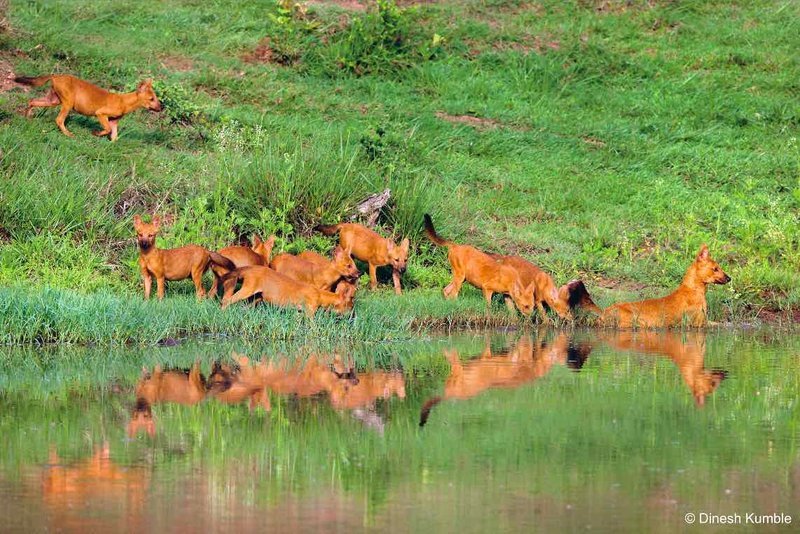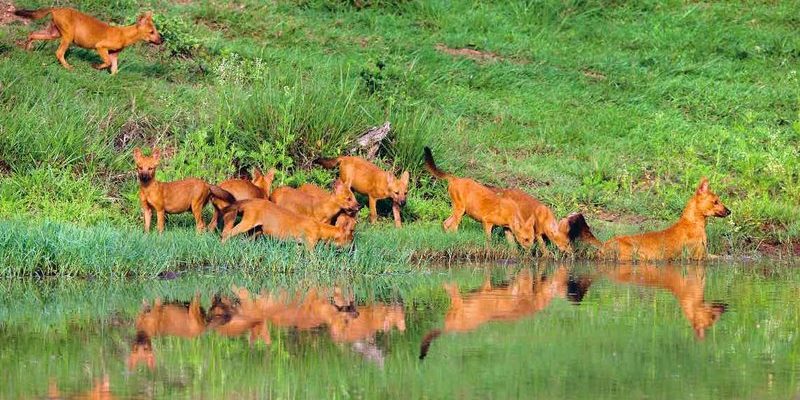
So, why should we care about the diet and hunting strategies of this underappreciated animal? Well, understanding doles helps us appreciate the complexity of nature and the intricate web of ecosystems they are part of. Their hunting techniques, social structure, and the way they adapt to their environment tell us a lot about survival in the wild. Whether you’re an animal enthusiast or just curious about wildlife, delving into the life of the dhole can be an eye-opening experience.
What is a Dhole?
To get started, let’s define what a dhole actually is. These medium-sized canines are mostly found in the forests and grasslands of Asia, especially in India, Southeast Asia, and parts of China. Dholes are distinguishable by their reddish-brown coats, bushy tails, and sleek bodies. They typically weigh between 30 to 40 pounds and can measure about 3 feet in length.
Dholes are social animals, living in packs that can range from 3 to 12 members. This social structure is not just for companionship; it plays a crucial role in their hunting strategies and overall survival. Each pack has a hierarchy, often led by an alpha male and female. This hierarchy helps to maintain order and effectiveness during hunting, which is essential for their survival.
The Dhole’s Diet
Now, let’s jump into the meat of the matter (no pun intended) — what do dholes actually eat? Dholes are carnivorous and primarily hunt for large mammals. Their diet mainly consists of:
- Deer (such as sambar and chital)
- Wild boar
- Small mammals (like hares and rodents)
- Birds and smaller game when necessary
Interestingly, though they prefer larger prey, dholes are opportunistic feeders. If they can’t find a big meal, they will easily switch to smaller animals. This flexibility is crucial for their survival, especially in changing environments.
Now, you might be wondering how they manage to snag these meals. Well, it’s not just about stealth; dholes employ a mix of teamwork and endurance to catch their prey. They are known to hunt in the early morning or late afternoon when their potential meals are most active.
Hunting Techniques of the Dhole
Here’s the thing about dholes: they aren’t your typical lone wolves. Their hunting strategies are highly cooperative, making them effective hunters. When they set out to hunt, they utilize a variety of techniques that highlight their intelligence and teamwork.
One of the key strategies is the use of vocalizations. Dholes communicate through a series of barks, whistles, and howls. This helps them coordinate with each other during a hunt. Imagine a well-orchestrated team where each member knows exactly what to do, and you’ll get a sense of how dholes operate.
Another technique is their endurance hunting. Dholes are built for stamina, allowing them to chase prey over long distances. They often wear down their target, working together to corner it. This method is particularly effective for larger animals that might have more strength but can tire out more quickly.
The Role of Pack Dynamics in Hunting
The dynamics of the dhole pack play a crucial role in their hunting success. Each member has a distinct role, much like a sports team where everyone has a specific position. The more experienced or larger members often take the lead, while younger members learn the ropes by following along.
Another fascinating aspect is the way they share their food. After a successful hunt, dholes will often engage in social behaviors such as play and grooming. This strengthens their bonds and ensures that everyone gets a share of the meal, promoting group cohesion. It’s almost like a community dinner where everyone pitches in, and no one is left out.
This social complexity provides not just a safety net for hunting but also helps in passing down skills to younger dholes. It’s a multi-generational learning process and a wonderful example of how cooperation can lead to success in the wild.
Adaptations to Different Environments
Dholes are truly adaptable creatures, and their hunting strategies change depending on their environment. In dense forests, they may rely more on stealth and ambush tactics, while in open grasslands, they can use their endurance and pack dynamics more effectively.
For instance, in regions where larger prey is scarce, dholes have been observed hunting in smaller, more agile groups to catch smaller animals. This adaptability is essential for their survival as it allows them to thrive in various ecosystems, from tropical forests to dry savannas.
Here’s a neat little fact: in some areas, dholes will even scavenge from larger predators, such as tigers and leopards. It’s not uncommon to see them boldly approaching a kill site, demonstrating their cleverness and resourcefulness.
Impact on Ecosystems
The presence of dholes within their ecosystems is more significant than you might think. As apex predators, they help manage populations of herbivores like deer, which in turn maintains the balance of vegetation in their habitat. This top-down control is vital for a healthy ecosystem.
Moreover, by preying on weaker or sick animals, dholes contribute to the overall health of prey populations, ensuring that only the fittest survive and reproduce. It’s a natural form of population control that emphasizes the importance of every species within an ecosystem.
You might not think about it often, but the hunting strategies and diet of a small pack of dholes can significantly influence the broader tapestry of life in their environment. By keeping herbivore numbers in check, they play a crucial role in preventing overgrazing and promoting biodiversity.
So, as we wrap this up, it’s clear that the diet and hunting strategies of the dhole are both fascinating and complex. These animals are not just survivors; they are key players in their ecosystems, relying on teamwork and adaptability to thrive. Their ability to adjust their hunting techniques based on environmental conditions shows us how resilience works in nature.
Understanding dholes provides us with valuable insights into the broader dynamics of wildlife and ecology. They remind us of the intricate relationships that exist within natural habitats, where every creature—big or small—plays a role. The next time you think about wildlife, consider the dhole and the important lessons its life can teach us about cooperation, adaptability, and balance in nature.

